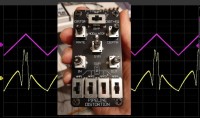Analog audio FX: Pipeline Distortion, build

Provides flexible and dynamic signal distortion as a sound effect for synthesizers and gitars. A chain of saturating amplifiers with switchable summation allows for many kinds of overdrive curves. A low-frequency modulator creates dynamically changing distortion.The PCB serves as frontpanel with knobs and switches, having other components at the back.
https://youtu.be/wRkLFAZR-kE
This is a follow-up on a previous post, June 2024, introducing the basic circuit and a prototype version.
An extended and build circuit with PCB design is shown here, circuit diagram and gerbers provided. All components are directly mounted on the PCB, apart from the supply connector. The circuit is explained in a few steps: concept, basic circuit, prototype, PCB-build.
Concept:
If you cascade identical amplifiers, then an increasing input signal will first saturate the last amp, then the amp before that, and so on. Now if you take the output of each amplifier and send this to an output summator, using adjustable gain and sign, you can create all kinds of saturation and distortion behaviour.
Concept implementation (see concept sketch):
Four cascaded amplifiers are used, each has a 3-position switch that allows the user to add-ignore-subtract the signal from it. In the circuits shown later, you could also use 100k potentiometers instead of these switches if you want more adjustment possibilities (at the expense of a more complex interface).
Circuit basic implementation (see basic circuit):
To keep things simple and cheap I used one chip (<1Euro) that contains six amplifiers:
the hex CMOS inverter 4049UB (UB=unbuffered version). These unbuffered logic gates are actually high-gain inverting amplifiers that can very well be used for analog purposes. This chip is widely available and active in production, even in DIL-package. Adding negative feedback using resistors sets the gain.
Cascading four of these amplifiers gives a circuit (the pipeline) where a rising input level sequentially saturates: amp4, amp4+3, amp 4+3+2, amp 4+3+2+1. if you now add/subtract the outputs of these amps you get various kinds of non-lineair functions.
The gain of amp1 is variable (input gain). Gain of amps 2,3,4 was chosen to be fixed 3V/V.Each amp output can be switched to amp number 5 (summing analog inverter to Amp6), to Amp 6 (overall summing amp), or switched off. Amp number 6 is also the output variable-gain stage.
Prototype on breadboard (see prototype circuit)
See https://www.elektormagazine.com/labs/analog-audio-effect-pipeline-distortion
Circuit build implementation (see PCB circuit):
Additions to the basic circuit: odd/even harmonics control(1), modulator(2) and equalizer(3):
1-If saturation occurs symmetric, you create odd harmonics, so a potmeter labelled "symmetry" has been added that allows the user to also tune in asymmetry and thereby have more even harmonics.
2-To make the effect more lively, a low frequency oscillator (LFO) is added that can slowly sweep the symmetry setting. The LFO has a "depth" and a "rate" potmeter, the resulting modulation signal, both depth and rate, is made visible with a LED. A dual CMOS opamp chip makes the LFO, see PCB circuit and prototype circuit.
3-Using the same a 3-position switch for "Bypass" or "Distortion" selection I decided to make the 3rd position "Distortion and Equaliser" adding a simple fixed bass and treble boost filter.
The total circuit runs best on a supply voltage of 4 to 5V and draws only a few mA. For the PCB version I connected two 2V7 zeners in series via a 1k resistor to a 9Vdc input, this way creating both 5V supply and 2V5 midrail reference. The total circuit has been build as a small (10x5cm) stand-alone effects unit for connecting to my (also homebuild) synthesizers.
Build version youtube link: https://youtu.be/wRkLFAZR-kE
Previous post of basics youtube link: https://youtu.be/f3LLiInagCY
My personal webpage: www.RS-elc.nl



Discussion (2 commentaire(s))